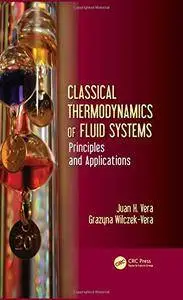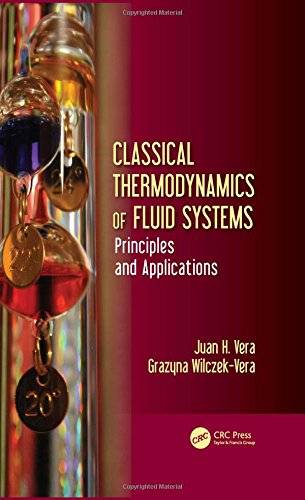Classical Thermodynamics of Fluid Systems: Principles and Applications
CRC Press | English | 2016 | ISBN-10: 1498767273 | 438 pages | PDF | 15.36 mb
CRC Press | English | 2016 | ISBN-10: 1498767273 | 438 pages | PDF | 15.36 mb
Juan H. Vera, Grazyna Wilczek-Vera
Provides a concise structure of concepts, using simple nomenclature and algebra.
Clarifies problems usually overlooked by standard texts.
Uses examples to show the structure for solving practical problems.
Includes diverse topics of interest to researchers and advanced students, including elements of statistical thermodynamics, models of solutions and the activity of individual ions. These topics give a coherent view of the authors’ contribution to thermodynamics.
Four appendices give step by step procedures and parameters for direct use of the PRSV equation of state for fugacities and the ASOG-KT group method for activity coefficients.
Summary
This text explores the connections between different thermodynamic subjects related to fluid systems. Emphasis is placed on the clarification of concepts by returning to the conceptual foundation of thermodynamics and special effort is directed to the use of a simple nomenclature and algebra. The book presents the structural elements of classical thermodynamics of fluid systems, covers the treatment of mixtures, and shows via examples and references both the usefulness and the limitations of classical thermodynamics for the treatment of practical problems related to fluid systems. It also includes diverse selected topics of interest to researchers and advanced students and four practical appendices, including an introduction to material balances and step-by-step procedures for using the Virial EOS and the PRSV EOS for fugacities and the ASOG-KT group method for activity coefficients. The Olivera-Fuentes table of PRSV parameters for more than 800 chemical compounds and the Gmehling-Tochigi tables of ASOG interaction parameters for 43 groups are included
Author(s) Bio
Juan H. Vera is Professor Emeritus, Department of Chemical Engineering, McGill University, Montreal, Canada. He received his Dr. Ing. (Ing. Quim.) from Universidad F. Santa Maria, Chile; M.Sc. (Chem. Eng.), University of California, Berkeley; Ing. Quim., U. Tecnica del Estado, Chile; and Lic. Quim. Ind., U. Tecnica del Estado, Chile. At McGill University, he served as Associate Dean (Research), Faculty of Engineering (2000–2004); Acting Dean, Faculty of Engineering (October–November 2003); President McGill Association of University Teachers, MAUT (1997–1998); Member of the Board of ResMIQ (2002–2004); Member of the Advisory Committee of Plasma Quebec (2002–2004); Engineering Faculty Representative to Plasturgie Quebec (2003); Engineering Faculty Representative to CRIAQ (2001–2004); and Associate Dean, Faculty of Graduate Studies and Research (1985–1988). He is coauthor of two textbooks, a manual on Copper Metallurgy (in Spanish) and over 190 refereed publications in international journals. He has an International Patent on Extraction of Proteins and a Canadian Patent on Extraction of Heavy Metals.
Grazyna Wilczek-Vera was Faculty Lecturer and Director of Undergraduate Studies in the Department of Chemistry and Research associate in the Department of Chemical Engineering at McGill University, Montreal, Canada, and Adjunct at the Department of Chemistry, University of Warsaw, Poland. She received the Principal’s Prize for Excellence in Teaching, 2008, at McGill University. She has authored 58 refereed publications, given 38 conference presentations, and coauthored two texts: Experimental Physical Chemistry for Biology Students, University of Warsaw, 1987 and Experimental Physical Chemistry for Chemistry Students, University of Warsaw, 1985. She also translated into Polish: R. A. Y. Jones, Physical and Mechanistic Organic Chemistry, Cambridge University Press, 1984. She received her Doctorate in Chemical Sciences (with Distinction), University of Warsaw and Master of Science in Chemistry (with Distinction), University of Warsaw, Poland.



